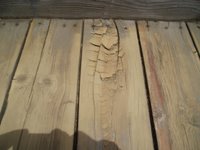My Goal:
Restore old splintered deck, without replacing wood.
Size: About 100 x 50 ft.
Time: About 4 hours
Type of deck: non treated, non color wood.
Do's:
- Most tool renters have floor sanders available. When you rent one, make sure they say its okay to use on the deck. This may help you from being liable if it breaks.
- Use a jitter bug type (sander shakes side to side or does circular motion)
- Shop around. Some are by the hour, others are by the day. I personally preferred the hour method.
- Floor sanders are heavy, make sure you have two people to get the device on your deck, and out of your car.
- Make sure the renter will buy back, unused sand paper. This way you can be safe and over stock without costs.
- Use 60 Grit sand paper.
- Get a new pad (goes between sandpaper and device) when using the floor sander
- Use belt sander on rails.
- Go around the edges with a belt sander after using floor sander
- Spot sanding by hand (for grooves in wood).
- When using stain, spend the extra money on something that will last longer.
- Consider a solid color to hide inconsistencies in your wood.
- If using a solid stain, use 2 coats, as the first will all get absorbed by your wood. This will also help prevent flaking the next year
- There's a good chance your wood was pressure treated. Use the proper health and environment precautions when sanding your wood.
Dont's:
- Don't use a hand/belt sander on main deck, it will take forever, plus you are more subject to chemicals in treated "pressed wood".
- Don't use the belted floor sanders, these have way too much torque and would eat into your wood a bit too fast and deep.
- Don't use equipment in the direct summer sun. Motor more likely to burn out.
- Don't use power water sprayer. This can leave uneven grooves, plus sharp edges that would need to be done over with a belt sander.
- Don't apply sealant until the entire area has been cleaned of sawdust. I recommend a shop-vac with some decent HP.
- Don't wait longer then a month or two to get the sealant on, as your deck is basically naked to the elements.
- Don't be cheap. There is a right tool for the right job. Use it!
- Don't take my advice as an end-all, but rather as a supplement to your research.
When I began, I couldn't get across the deck, without getting at least one splinter in the foot. After my work was completed (sanding, seal, etc), I am now able to moon walk bare footed on the deck!



2 comments:
Thanks Jeff, I plan to restore my deck in the next couple of months and I'll heed your warning and post my experience on my blog too - MyLittlePortal.com. I found what looks like nice sander on this site lattaequipment.com - it takes special "Deck Attachment Plates" so won't clog like sandpaper and set of 3 plates should be enough for my entire deck. Don't know where I can rent one but I've just started my research!
Cheers
Richard
I enjoyed reading this post as it pertains to a large ipe project where the builder did his own deck prep and just about ruined the surface of this very expensive hardwood. We are now going to have to sand it down.
The large majority of decks do not need to be sanded. With a careful use of the right deck cleaners and pH balancing agents most old decks can be restored. The problem is, the vast majority, if not all cleaners sold at Home Depot, Lowe's and the ilk are bleach based which is nearly useless for deck restoration. We released a product called Restore-A-Deck two years ago to the public. So far all results reported have ben posiitive. I wish I could post some of the pictures DIY customers have sent to me.
Post a Comment